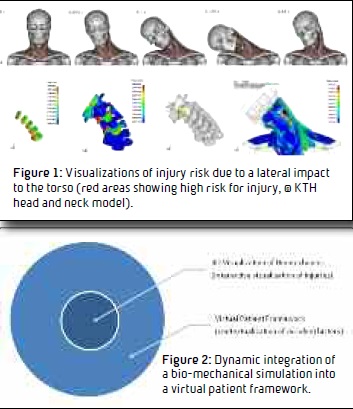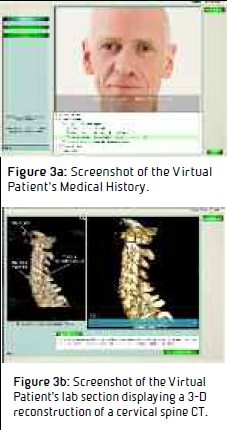➣ By Olivier Courteille, Hans von Holst & Li Felländer-Tsai

The quality of clinical decision making in the treatment of trauma patients could be significantly improved by promoting the history of the accident as an important supplement to generally accepted diagnostic tools like computerized tomography (CT) or magnetic resonance (MRI). However, this kind of investigation is complex and involves a biomechanical perspective in the diagnosis, a knowledge that is not part of the curriculum for physicians, physiotherapists, occupational therapists or nurses today.
This is particularly the case of injuries in the head and neck region which are often acute and multi-faceted, involving hard and soft tissues. Thus, to be able to handle these cases and decide on proper investigation and treatment procedures, medical students and residents need to be trained with more dedicated learning tools to learn the underlying anatomical and physiological, as well as biomechanical, properties of such injuries.
Educational Computer Simulation Model
New immersive and authentic learning environments are thus needed to enhance the interactive visualization and understanding of injury mechanisms in a contextualized accident history. Embracing the increasing trend advocating for integrated simulations, joined efforts led by the Royal Institute of Technology (KTH) and the Karolinska Institute (KI) in Sweden gave birth to the VIS-Ed (Visualization through Imaging and Simulation) educational model. VIS-Ed is namely a mixed simulation-based virtual learning environment that aims to improve the clinical diagnosis and treatment of head and neck injuries for medical education, in particular, for specialist training in orthopedics and neurosurgery.
 VIS-Ed enables a dynamic integration of a biomechanical simulation, featuring the interactive visualization of injuries, into a virtual patient (VP) framework, providing the conceptualization of accident history.
VIS-Ed enables a dynamic integration of a biomechanical simulation, featuring the interactive visualization of injuries, into a virtual patient (VP) framework, providing the conceptualization of accident history.
Through the VP-based contextualization of the accident history, this educational model favors experiential learning, which is beneficial for knowledge acquisition, retention and skill transfer. Moreover, the interactive biomechanical simulation of the injury makes it possible to easily visualize therapy and rehabilitation outcomes, and consequently, better understand their impact over time on patient condition.
Virtual Patient
The patient cases are portrayed using Virtual Patients, where trainees can investigate the clinical case, make decisions and explore the consequences of their actions. This includes taking the patient’s medical history, examining the patient, and ordering lab/imaging tests.
Interactive Visualization of Traumabiomechanical Events
The 3-D interactive visualization of biomechanical events related to the accident is based on the Finite Element Method (FEM), where the user can easily explore the forces the skull, neck and soft tissues have been exposed to. The animated biomechanical simulation can display, in detail, the impact on the cervical vertebrae and muscles.
Ongoing Work
A preliminary study with a motorcycle accident case was recently undertaken involving nine participants (five medical students and four residents). We investigated how trainees can take advantage of these integrated visualization techniques to better understand how head and neck injuries should be handled clinically. Data collection included:
- The perceived usefulness of the model
- Participants’ appraisals about the educational potential of this mixed learning tool
- Suggestions for technical and educational improvements
The preliminary results were very promising. Participants were very positive about VIS-Ed and overwhelmingly favored this kind of (mixed) learning method to the traditional one. They also perceived that this computermediated activity would help them to better understand and visualize biomechanical injuries and the effectiveness of suggested therapy. Finally, they believed they would be better prepared to assess and treat similar head and neck injuries if such models were to be implemented in the medical curriculum.
Levels of acceptability and satisfaction were high and valuable recommendations for further improvements of the VIS-Ed model and its learning components were also provided. A new control study is currently investigating if VIS-Ed can significantly improve the clinical diagnosis and treatment in head and neck trauma situations for undergraduate student education and specialist training in orthopedics.
Future Directions
- More targeted interactive and immersive educational models are needed on head and neck injuries and their prevention.
- The range of use of VIS-Ed like Mixed Virtual Learning Environments extends beyond undergraduate student education and specialist training for physicians and also includes physiotherapists, occupational therapists and nurses.
- Safety promotion and injury promotion have also been identified as natural areas for VIS-Ed (like consequences of violence in schools, childcare clinics and young parents, drivers’ license education, life guard training, etc.).
Olivier Courteille, Ph.D., M.Sc.
Karolinska Institutet
Li Felländer-Tsai, Ph.D., M.D.
Hans von Holst, Ph.D., M.D.
Karolinska University Hospital
Sweden
Olivier.Courteille@ki.se
About Brenda Wiederhold
President of Virtual Reality Medical Institute (VRMI) in Brussels, Belgium.
Executive VP Virtual Reality Medical Center (VRMC), based in San Diego and Los Angeles, California.
CEO of Interactive Media Institute a 501c3 non-profit
Clinical Instructor in Department of Psychiatry at UCSD
Founder of CyberPsychology, CyberTherapy, & Social Networking Conference
Visiting Professor at Catholic University Milan.






